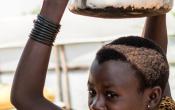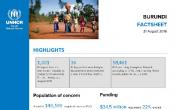Burundi
Operation: Burundi
Location
{"longitude":30,"latitude":-3,"zoom_level":8}
Latest update of camps and office locations 21 Nov 2016. By clicking on the icons on the map, additional information is displayed.
Key Figures
| 2016 end-year results | |
| 100% | of children under five years and people with specific needs were provided with supplementary food |
| 100% | of all refugees in camps had access to primary healthcare services while 3,500 refugees in urban areas were supported |
| 18,200 | identity cards were provided to refugees in camps and urban areas |
| 14,000 | 14,000 refugees in camps received basic and domestic items, including mosquito nets |
| 2017 planning figures | |
| 100% | primary healthcare access coverage will be reached for refugees and asylum-seekers |
| 100% | of refugee and asylum-seeker women will be provided with hygienic supplies |
| 85% | of refugee and asylum-seeking children will be registered in primary school |
| 1,200 | Burundian families will receive domestic appliances, including blankets and cooking utensils, upon return |
| 18 | liters of water, in average, will be available daily for each refugee and asylum seeker |
Latest Updates and Related Links
People of Concern
147%
Increase in
2016
2016
| 2016 | 208,049 |
| 2015 | 84,399 |
| 2014 | 138,111 |

[["Refugees",57469],["Asylum-seekers",3613],["IDPs",141221],["Returned refugees",4117],["Stateless",974],["Others of concern",655]]
Loading ...
Burundi
< Back
2016
{"categories":[2012,2013,2014,2015,2016,2017],"budget":[30.82084694,31.54391216,25.31822673,33.021793127,34.53884162,33.81553606],"expenditure":[23.31374845,22.90897204,20.51341054,15.61407482,17.32505948,null]}
{"categories":[2012,2013,2014,2015,2016,2017],"p1":[28.89418648,30.24224219,23.3993674,18.676158177,28.50049693,29.42440961],"p2":[0.66325324,0.61934524,0.36923053,0.18940178,0.92834469,0.007075],"p3":[null,null,null,null,null,null],"p4":[1.26340722,0.68232473,1.5496288,14.15623317,5.11,4.38405145]}
{"categories":[2012,2013,2014,2015,2016,2017],"p1":[21.85597865,21.96405858,18.59464165,14.14254743,15.49302301,null],"p2":[0.47947212,0.52827801,0.36918882,0.13616865,0.1221779,null],"p3":[null,null,null,null,null,null],"p4":[0.97829768,0.41663545,1.54958007,1.33535874,1.70985857,null]}
Loading ...
CHOOSE A YEAR
- 2014
- 2015
- 2016
- 2017
Working environment
UNHCR maintained the Level 2 emergency declared in Burundi in May 2015 when election-related violence began and triggered the displacement of thousands of people, including 120,000 new Burundian refugees fleeing to neighbouring countries in 2016. In 2016, the overall situation in Burundi remained tense and fragile in some areas in the country with limited access to urban refugees, internally displaced people (IDPs) and spontaneous returnees. The civil society and other organizations reported violations of human rights.By the end of 2016, over 360,000 Burundian refugees were hosted in the Democratic Republic of the Congo (DRC), Rwanda, Uganda and the United Republic of Tanzania.
Population trends
- Despite the on-going security situation in the country, some 5,500 new people sought refuge in 2016. Burundi hosted 61,082 refugees and asylum seekers mainly from the DRC in urban areas and four camps.
- In addition, 974 people at risk statelessness were registered in the country.
- Some 102,250 were registered as internally displaced people.
Achievements and impact
- UNHCR negotiated with the Government of Burundi to establish a fifth camp to host refugees. Reception conditions and facilities were improved in Kavumu camp.
- UNHCR distributed 288 construction kits and core relief items to spontaneous returnees and other vulnerable people.
- Malnutrition was reduced as a result of the implementation of an infant growth surveillance system.
- UNHCR advocated with public health structures to include urban refugees into national health structures and to facilitate access to medicines.
Unmet needs
- 29 per cent of children at risk identified could not benefit from best interest assessment and determination (BIA/ BID) due to funding shortage.
- A plan to integrate refugees into the national health scheme could not be achieved.
- Monitoring of protection activities for returnees could not be carried out throughout the territory.
In 2016, UNHCR will conduct its operations in Burundi in a complex environment following electoral tensions which led to the outflow of close to 200,000 refugees since April 2015.
The 2008 Law on Asylum and the Protection of Refugees guarantees the right to asylum. The Government of Burundi has made land available for refugee camps. All refugees in the country enjoy freedom of movement, and refugee children are able to go to public schools, in the same conditions as Burundian children.
In 2016, UNHCR’s main priorities will include:
- Support the Government of Burundi’s efforts to improve the protection environment and assistance for people of concern;
- Intensify activities for the prevention of sexual and gender-based violence (SGBV);
- Pursue the resettlement programme with the objective of submitting 3,500 cases;
- Foster economic empowerment and seek to further the local integration of refugees;
- Engage in IDP assistance if contingency plans (national and inter-agency) are activated.
- Protection risks would increase (prevention and response of SGBV would be ineffective, and essential needs would not be covered);
- Activities relating to economic empowerment and local integration of refugees would not be implemented;
- Peaceful coexistence with the host population would be challenged.






